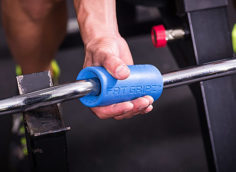Big Questions
Answer these questions:
- How much do you bench?
- What's your squat?
- How much can you deadlift?
Guaranteed, the numbers in your head right now are your best single rep for each lift – your one-rep max (1RM).
But what if I'd asked you how much weight you can handle on those lifts for 5, 8, or 12 reps? Chances are, you'd have to give it quite a bit of thought. That needs to change.
Who Cares?
Lifting culture is definitely big on max poundage, but here's another question: Why do we care so much about our 1RM? Though we tend to use our maxes as an ego boost, the reality is that your 1RM is a complex interplay of genetics, levers, training status, experience, and technique.
What a 1RM isn't is an accurate reflection of how hard you work in the gym. Outside of competitive strength athletes – powerlifters, Olympic lifters or competitive CrossFitters – the rest of us should care a lot less about our 1RMs than we actually do.
A simple analysis of risks and rewards will easily tip the scale away from 1RM training... and even further away from 1RM testing.
The Rewards
- Strength: You're stronger. Hitting a new 1RM provides tangible proof that your hard work is paying off. What you just did is something you couldn't do last week or last month, so clearly you've brought your strength to a whole new level.
- Motivation: Hitting a new PR is highly satisfying. The pure adrenalin rush of success can be incredibly motivating and will often carry over into subsequent workouts.
- Confidence: Every other weight gets lighter. While this is mostly a psychological thing, you develop a new level of confidence with sub-max weights, often allowing you to add a rep or two.
The Risks
- Acute Injury: Technique has a tendency to break down on max attempts. You can lose spinal stiffness on your squat or deadlift and tweak your back. Fighting through the sticking point on the bench throws your shoulders out of alignment and the resulting injury can stall your progress over the next few weeks or even months.
- Overuse Injury: Heavy weights put a lot of strain on joints and connective tissues. Over time, subjecting them to max or near-max weights too often leads to breakdowns. Tendinitis is a nightmare to come back from. Achy wrists, cranky elbows, and wonky knees will prevent you from getting the job done.
- No Time Under Tension: Training for maximal strength is actually more about priming the nervous system to recruit as many motor units as possible for a single, all-out effort. You won't build muscle that way. Muscles require significant time under tension to be stimulated into growing. Heavy singles just don't do that.
- High Stress: Psyching yourself up for a max attempt is stressful. Cortisol production skyrockets and the strain on the nervous system builds up. Both of these factors will work against you in the long run.
What to Do Instead
With tongue firmly planted in cheek, I propose to eliminate 1RM attempts from gyms everywhere. Banned. Not allowed. If it's not on a competition platform, you just can't do it.
Not buying it? Okay, fair enough. But having a singular focus on building up your 1RM numbers is inherently too risky to be worth it unless you're sport requires it. It's also pretty ineffective for building muscle or getting stronger. Remember, 1RMs are a display of strength, not a builder of strength.
Instead, give yourself multiple opportunities to experience success by systematically tracking multiple "rep maxes."
For the next month or so, establish baseline numbers for your 3RM, 5RM, 8RM, 10RM, and 12RM for one or two compound exercises for each major lifting pattern. I'd also throw in a 20RM for the squat for the brave among you.
Here's what it could look like, but feel free to substitute exercises:
- Squat: Back squat and/or front squat
- Hip hinge: Conventional deadlift or Romanian deadlift
- Lunge: Non-alternating walking lunge or Bulgarian split squat
- Horizontal press: Flat dumbbell press and incline dumbbell press
- Vertical press: Military press or push press
- Horizontal pull: Bentover row or one-arm row
- Vertical pull: Pull-up (with added load as needed)
In week 1, as a part of your regular weekly training program, ramp up to a single 12RM test set for each exercise. In week 2, do the same for your 10RM, continuing on in this way to testing your 3RM in week 5. On a dedicated page in your training logbook or on a simple Excel spreadsheet, keep track of your numbers.
You now have five different PRs to chase (six for the squat) for many of your favorite exercises. This gives you multiple goals and multiple avenues for success.
Feeling strong on leg day? Shoot for a new 3RM or 5RM on the squat. Even if you come up a little short, you'll still have 2-4 solid reps completed. Energetic today? Try to beat your 12RM on the military press.
Every time you set a new PR, you'll experience each of the rewards described above without the downside of 1RM training. You'll also build a hell of a lot more muscle.





